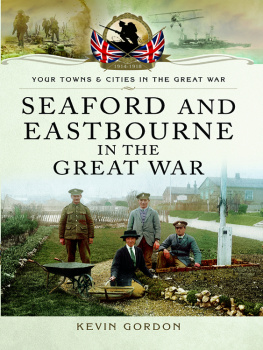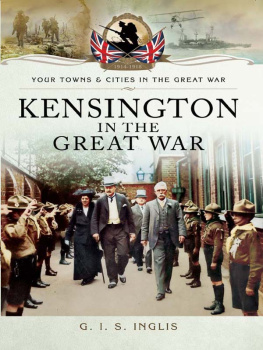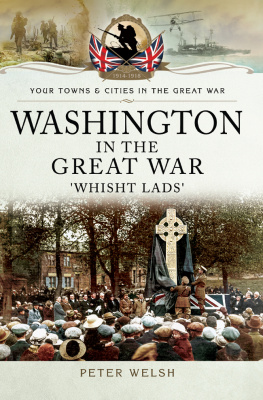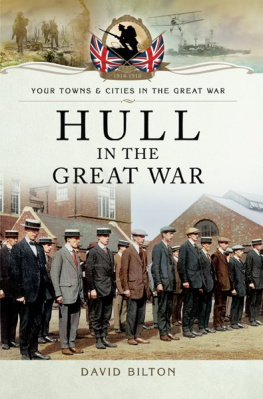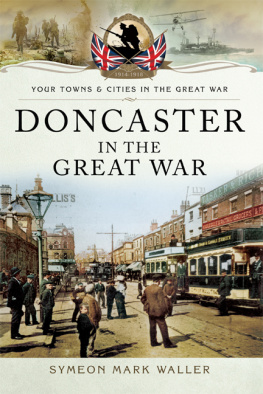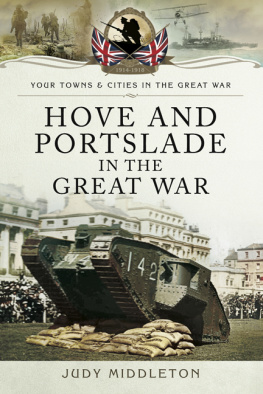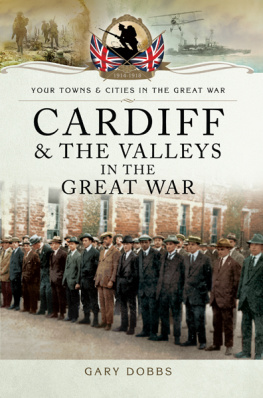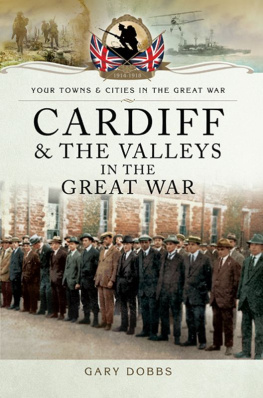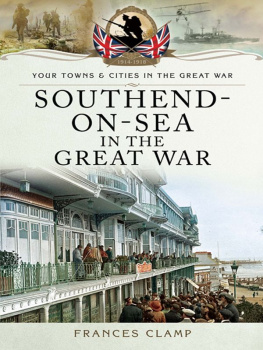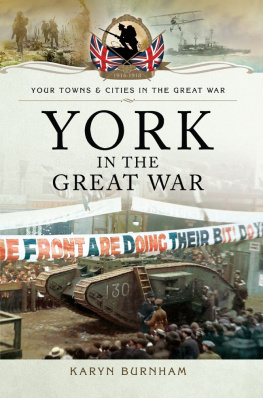
Your Towns and Cities in the Great War

Seaford and Eastbourne
in the Great War
Your Towns and Cities in the Great War

Seaford and Eastbourne
in the Great War
Kevin Gordon

First published in Great Britain in 2014 by
PEN & SWORD MILITARY
an imprint of
Pen and Sword Books Ltd
47 Church Street
Barnsley
South Yorkshire S70 2AS
Copyright Kevin Gordon, 2014
ISBN 978 1 78303 642 4
The right of Kevin Gordon to be identified as the author of
this work has been asserted by him in accordance with the Copyright,
Designs and Patents Act 1988.
A CIP record for this book is available from the British Library
All rights reserved. No part of this book may be reproduced or transmitted
in any form or by any means, electronic or mechanical including
photocopying, recording or by any information storage and retrieval
system, without permission from the Publisher in writing.
Printed and bound in England
by CPI Group (UK) Ltd, Croydon, CR0 4YY
Typeset in Times New Roman by Chic Graphics
Pen & Sword Books Ltd incorporates the imprints of
Pen & Sword Archaeology, Atlas, Aviation, Battleground, Discovery,
Family History, History, Maritime, Military, Naval, Politics, Railways,
Select, Social History, Transport, True Crime, and Claymore Press,
Frontline Books, Leo Cooper, Praetorian Press, Remember When,
Seaforth Publishing and Wharncliffe.
For a complete list of Pen and Sword titles please contact
Pen and Sword Books Limited
47 Church Street, Barnsley, South Yorkshire, S70 2AS, England
E-mail:
Website: www.pen-and-sword.co.uk
Acknowledgements

When I took on the challenge of writing this book about the Great War I sought advice from Brigid Chapman from Lewes, who kindly assisted me.
Paul Waller pointed me towards information about schools during the war and Phil Armstrong and Ben Franks assisted with photographs. All are volunteers at the Seaford Museum Archives. Other photographs have been kindly supplied by Rosemary Holland, Jim Marsh, Peter Mason, East Sussex Libraries and Peter White
Peter Fellows and Norman Franks gave me invaluable information about the early RAF. Lionel Jones and the staff of Eastbourne Library also cheerfully assisted me.
I am particular indebted to Rodney Castleden who edited my writing to manageable proportions. He kindly shared his knowledge as an experienced author of history books.
Lastly, I would like to thank my wife Mandy, for her support and patience.
Introduction

One hundred years ago, the most catastrophic war affected every city, town and village in Britain and had long-lasting global repercussions.
I have always been fascinated by the Great War. The story of my grandfather, Alex Gordon, was one of bravery, excitement and pain. When his leg was blown off during the Zeebrugge Raid on 24 April 1918, he must have suffered terribly but he was always cheerful. Sadly, his experience was not unusual. Everyone in the county had at least one family member or friend who had a similar story of suffering to tell, if they survived, and of course many of them were never to return home.
Although the whole country was embroiled in the war, the coastal towns of Seaford and Eastbourne in Sussex were closer to it than most places. Naval battles could be heard from the towns and sometimes even seen by those who had a good pair of binoculars. Thousands of troops were billeted in the area either in private homes or in massive camps like the two at Seaford.
Sources of information are sometimes difficult for a period that teeters on the brink of human memory. The first-hand sources, the soldiers, have all gone now. The last surviving British soldiers of the Great War, 111-year-old Harry Patch and 113-year-old Henry Allingham, died within a few days of each other in 2009. Henry lived in Eastbourne and died at St Dunstans Home (Blind Veterans UK) at Ovingdean. Thousands of local men died in the conflict, all with stories to tell, even though today they may have become little more than names on a war memorial. But the story of the war is wider than the story of soldiers. Other groups of people were involved too, such as women and conscientious objectors. The civilian populations of Seaford and Eastbourne had their own very different experience of the Great War.
The primary sources for this book heavily feature contemporary newspapers. Archive material from local museums has been used too. Newhaven Fort, Eastbourne Redoubt and the smaller museums at Seaford and Newhaven proved rich sources of information.
Other books have been written about this stretch of the Sussex coast in the Great War, most notably Bob Ellistons Eastbournes Great War, so this book seeks to avoid unnecessary duplication of coverage. To give another example, the early days of aviation at Eastbourne and the subsequent role of aviation in the Great War have been covered comprehensively in a resource published by the Eastbourne History Society: The Eastbourne Aviation Company 1911-1924. For details on early aviation at Eastbourne, the reader is recommended to use that. Other sources for this book are listed in the bibliography.
CHAPTER 1
Prelude to War

A background of conflict
Seaford and Eastbourne have been on the frontier of invasion and conflict for thousands of years. The Roman occupation and the Norman Conquest both made direct impacts on this stretch of the Sussex coast. During the Hundred Years War in the Middle Ages there were frequent assaults by the French.
By the thirteenth century Seaford had become an important port, thanks to the export of wool to the continent. By 1229 it was a Cinque Port, a part of the confederation of south coast ports that supplied ships and men to protect the country prior to the creation of the Royal Navy. Seaford was a limb, a subsidiary port, of Hastings along with nearby Pevensey. French attacks and the Black Death decimated the populations of Eastbourne and Seaford. In 1380, Seaford was given remission from taxes due to the frequency of the French raids. As families moved inland into the safety of the Downs, villages such as Alfriston and Hailsham started to grow. Eastbourne at this time was a small settlement called Bourn, clustered round St Marys Church, but it still had to contribute. During the reign of Edward III the village was taxed to provide funds to fight the French.
Probably the last invasion attempt on this section of the coast came on 18 July 1545 when a French fleet, under the command of Admiral Claude DAnnebault, landed in Seaford Bay. The local landowner, Sir Nicholas Pelham, was also Commander of Musters in Sussex. It was his responsibility to gather militias and any available local people to fight off the foreigners, and together they succeeded in pushing the French back on to their ships.
In 1587, anticipating a Spanish invasion, a survey of the Sussex coast was made by Sir Thomas Palmere and Walter Covert, who were deputy lieutenants of the county. They reported that at Bourn there was a decayed earthen bulwark and that, although there were cannon, they were unfurnished with powdre and shotte. There were similar earthworks at Newhaven and at Seaford. At nearby Chyngton Farm the gun carriages were utterly decayed and all along the coast it was obvious there was a need for more ordnance. The people of Seaford and Eastbourne must have been in a high state of alert when the Spanish Armada passed along the coast a few months later, on 25 July 1588.
Next page
